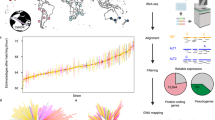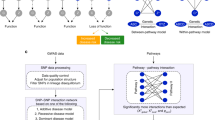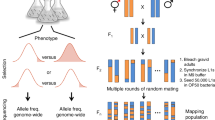Abstract
Most heritable traits, including disease susceptibility, are affected by interactions between multiple genes. However, we understand little about how genes interact because very few possible genetic interactions have been explored experimentally. We have used RNA interference in Caenorhabditis elegans to systematically test ∼65,000 pairs of genes for their ability to interact genetically. We identify ∼350 genetic interactions between genes functioning in signaling pathways that are mutated in human diseases, including components of the EGF/Ras, Notch and Wnt pathways. Most notably, we identify a class of highly connected 'hub' genes: inactivation of these genes can enhance the phenotypic consequences of mutation of many different genes. These hub genes all encode chromatin regulators, and their activity as genetic hubs seems to be conserved across animals. We propose that these genes function as general buffers of genetic variation and that these hub genes may act as modifier genes in multiple, mechanistically unrelated genetic diseases in humans.
This is a preview of subscription content, access via your institution
Access options
Subscribe to this journal
Receive 12 print issues and online access
$209.00 per year
only $17.42 per issue
Buy this article
- Purchase on Springer Link
- Instant access to full article PDF
Prices may be subject to local taxes which are calculated during checkout





Similar content being viewed by others
References
Badano, J.L. & Katsanis, N. Beyond Mendel: an evolving view of human genetic disease transmission. Nat. Rev. Genet. 3, 779–789 (2002).
Fearon, E.R. & Vogelstein, B. A genetic model for colorectal tumorigenesis. Cell 61, 759–767 (1990).
Hartman, J.L.t., Garvik, B. & Hartwell, L. Principles for the buffering of genetic variation. Science 291, 1001–1004 (2001).
Tong, A.H. et al. Systematic genetic analysis with ordered arrays of yeast deletion mutants. Science 294, 2364–2368 (2001).
Tong, A.H. et al. Global mapping of the yeast genetic interaction network. Science 303, 808–813 (2004).
Davierwala, A.P. et al. The synthetic genetic interaction spectrum of essential genes. Nat. Genet. 37, 1147–1152 (2005).
van Haaften, G., Vastenhouw, N.L., Nollen, E.A., Plasterk, R.H. & Tijsterman, M. Gene interactions in the DNA damage-response pathway identified by genome-wide RNA-interference analysis of synthetic lethality. Proc. Natl. Acad. Sci. USA 101, 12992–12996 (2004).
Baugh, L.R. et al. Synthetic lethal analysis of Caenorhabditis elegans posterior embryonic patterning genes identifies conserved genetic interactions. Genome Biol. 6, R45 (2005).
Timmons, L. & Fire, A. Specific interference by ingested dsRNA. Nature 395, 854 (1998).
Kamath, R.S. et al. Systematic functional analysis of the Caenorhabditis elegans genome using RNAi. Nature 421, 231–237 (2003).
Sundaram, M.V. RTK/Ras/MAP kinase signaling. WormBook [online] <http://www.wormbook.org>, published online 11 February 2006 (doi/10.1895/wormbook.1.80.1).
Wang, D. et al. Somatic misexpression of germline P granules and enhanced RNA interference in retinoblastoma pathway mutants. Nature 436, 593–597 (2005).
Lehner, B. et al. Loss of LIN-35, the Caenorhabditis elegans ortholog of the tumor suppressor p105Rb, results in enhanced RNA interference. Genome Biol. 7, R4 (2006).
Kinchen, J.M. & Hengartner, M.O. Tales of cannibalism, suicide, and murder: programmed cell death in C. elegans. Curr. Top. Dev. Biol. 65, 1–45 (2005).
Howard, R.M. & Sundaram, M.V. C. elegans EOR-1/PLZF and EOR-2 positively regulate Ras and Wnt signaling and function redundantly with LIN-25 and the SUR-2 Mediator component. Genes Dev. 16, 1815–1827 (2002).
Kokel, M., Borland, C.Z., DeLong, L., Horvitz, H.R. & Stern, M.J. clr-1 encodes a receptor tyrosine phosphatase that negatively regulates an FGF receptor signaling pathway in Caenorhabditis elegans. Genes Dev. 12, 1425–1437 (1998).
Bergman, A. & Siegal, M.L. Evolutionary capacitance as a general feature of complex gene networks. Nature 424, 549–552 (2003).
Rutherford, S.L. & Lindquist, S. Hsp90 as a capacitor for morphological evolution. Nature 396, 336–342 (1998).
Queitsch, C., Sangster, T.A. & Lindquist, S. Hsp90 as a capacitor of phenotypic variation. Nature 417, 618–624 (2002).
Ceol, C.J. & Horvitz, H.R. A new class of C. elegans synMuv genes implicates a Tip60/NuA4-like HAT complex as a negative regulator of Ras signaling. Dev. Cell 6, 563–576 (2004).
Moghal, N. & Sternberg, P.W. A component of the transcriptional mediator complex inhibits RAS-dependent vulval fate specification in C. elegans. Development 130, 57–69 (2003).
Jiang, L.I. & Sternberg, P.W. An HMG1-like protein facilitates Wnt signaling in Caenorhabditis elegans. Genes Dev. 13, 877–889 (1999).
Ludewig, A.H. et al. A novel nuclear receptor/coregulator complex controls C. elegans lipid metabolism, larval development, and aging. Genes Dev. 18, 2120–2133 (2004).
Herman, M.A. et al. EGL-27 is similar to a metastasis-associated factor and controls cell polarity and cell migration in C. elegans. Development 126, 1055–1064 (1999).
Sollars, V. et al. Evidence for an epigenetic mechanism by which Hsp90 acts as a capacitor for morphological evolution. Nat. Genet. 33, 70–74 (2003).
George, S.E., Simokat, K., Hardin, J. & Chisholm, A.D. The VAB-1 Eph receptor tyrosine kinase functions in neural and epithelial morphogenesis in C. elegans. Cell 92, 633–643 (1998).
Clark, D.V., Suleman, D.S., Beckenbach, K.A., Gilchrist, E.J. & Baillie, D.L. Molecular cloning and characterization of the dpy-20 gene of Caenorhabditis elegans. Mol. Gen. Genet. 247, 367–378 (1995).
Zhang, H. & Emmons, S.W. The novel C. elegans gene sop-3 modulates Wnt signaling to regulate Hox gene expression. Development 128, 767–777 (2001).
Solari, F. & Ahringer, J. NURD-complex genes antagonise Ras-induced vulval development in Caenorhabditis elegans. Curr. Biol. 10, 223–226 (2000).
Ch'ng, Q. & Kenyon, C. egl-27 generates anteroposterior patterns of cell fusion in C. elegans by regulating Hox gene expression and Hox protein function. Development 126, 3303–3312 (1999).
Rebay, I. et al. A genetic screen for novel components of the Ras/Mitogen-activated protein kinase signaling pathway that interact with the yan gene of Drosophila identifies split ends, a new RNA recognition motif-containing protein. Genetics 154, 695–712 (2000).
Chen, F. & Rebay, I. split ends, a new component of the Drosophila EGF receptor pathway, regulates development of midline glial cells. Curr. Biol. 10, 943–946 (2000).
Lin, H.V. et al. Splits ends is a tissue/promoter specific regulator of Wingless signaling. Development 130, 3125–3135 (2003).
Staehling-Hampton, K., Ciampa, P.J., Brook, A. & Dyson, N. A genetic screen for modifiers of E2F in Drosophila melanogaster. Genetics 153, 275–287 (1999).
Wiellette, E.L. et al. spen encodes an RNP motif protein that interacts with Hox pathways to repress the development of head-like sclerites in the Drosophila trunk. Development 126, 5373–5385 (1999).
Kuang, B., Wu, S.C., Shin, Y., Luo, L. & Kolodziej, P. split ends encodes large nuclear proteins that regulate neuronal cell fate and axon extension in the Drosophila embryo. Development 127, 1517–1529 (2000).
Kuroda, K. et al. Regulation of marginal zone B cell development by MINT, a suppressor of Notch/RBP-J signaling pathway. Immunity 18, 301–312 (2003).
Oswald, F. et al. SHARP is a novel component of the Notch/RBP-Jkappa signalling pathway. EMBO J. 21, 5417–5426 (2002).
Shi, Y. et al. Sharp, an inducible cofactor that integrates nuclear receptor repression and activation. Genes Dev. 15, 1140–1151 (2001).
Bach, E.A., Vincent, S., Zeidler, M.P. & Perrimon, N. A sensitized genetic screen to identify novel regulators and components of the Drosophila janus kinase/signal transducer and activator of transcription pathway. Genetics 165, 1149–1166 (2003).
Janody, F., Benlali, A., Martirosyan, Z. & Treisman, J. Blind spot and Kohtalo, two components of the Drosophila mediator complex, act together to control a subset of Hedgehog and Wingless target genes. A. Dros. Res. Conf. 43, 90 (2002).
Carrera, I., Janody, F., Martirosyan, Z. & Treisman, J. Two subunits of the mediator complex act as adaptors for Notch and Wingless signaling. A. Dros. Res. Conf. 44, 346A (2003).
Gause, M. et al. Nipped-A, the Tra1/TRRAP subunit of the Drosophila SAGA and Tip60 complexes, has multiple roles in Notch signaling during wing development. Mol. Cell. Biol. 26, 2347–2359 (2006).
Xiao, H., Chung, J., Kao, H.Y. & Yang, Y.C. Tip60 is a co-repressor for STAT3. J. Biol. Chem. 278, 11197–11204 (2003).
Feng, Y., Lee, N. & Fearon, E.R. TIP49 regulates beta-catenin-mediated neoplastic transformation and T-cell factor target gene induction via effects on chromatin remodeling. Cancer Res. 63, 8726–8734 (2003).
Taubert, S. et al. E2F-dependent histone acetylation and recruitment of the Tip60 acetyltransferase complex to chromatin in late G1. Mol. Cell. Biol. 24, 4546–4556 (2004).
Berns, K. et al. A large-scale RNAi screen in human cells identifies new components of the p53 pathway. Nature 428, 431–437 (2004).
Inoue, T. et al. Gene expression markers for Caenorhabditis elegans vulval cells. Mech. Dev. 119 (Suppl.), S203–S209 (2002).
Acknowledgements
We thank the C. elegans Genetics Center for providing strains and E. Marcotte, D. Stemple, I. Barroso and T. Vavouri for comments on the manuscript. B.L. is supported by a Sanger Institute Postdoctoral Fellowship. C.C., J.T., A.F. and A.G.F. are supported by the Wellcome Trust.
Author information
Authors and Affiliations
Contributions
B.L. and A.G.F. designed the experiments. B.L., C.C., J.T., A.F. and A.G.F. performed the experiments. B.L. and A.G.F. analyzed the data and wrote the paper.
Note: Supplementary information is available on the Nature Genetics website..
Corresponding author
Ethics declarations
Competing interests
The authors declare no competing financial interests.
Supplementary information
Supplementary Table 1
Tab-delimited list of the library RNAi bacterial feeding clones screened in each strain. (XLS 249 kb)
Supplementary Table 2
Tab-delimited list of identified synthetic genetic enhancer interactions. (XLS 62 kb)
Supplementary Table 3
Identification of EGF pathway genes and genes previously shown to interact genetically with EGF pathway components. (PDF 44 kb)
Supplementary Table 4
Genes that interact with two or more components of the EGF pathway. (PDF 60 kb)
Supplementary Table 5
Interactions of additional genes with the top six hub genes. (PDF 54 kb)
Supplementary Table 6
Known functions of the fly and mammalian orthologs of the six most highly connected hub genes in the genetic interaction network. (PDF 75 kb)
Rights and permissions
About this article
Cite this article
Lehner, B., Crombie, C., Tischler, J. et al. Systematic mapping of genetic interactions in Caenorhabditis elegans identifies common modifiers of diverse signaling pathways. Nat Genet 38, 896–903 (2006). https://doi.org/10.1038/ng1844
Received:
Accepted:
Published:
Issue Date:
DOI: https://doi.org/10.1038/ng1844
This article is cited by
-
A dual sgRNA library design to probe genetic modifiers using genome-wide CRISPRi screens
BMC Genomics (2023)
-
The Y-ome Conundrum: Insights into Uncharacterized Genes and Approaches for Functional Annotation
Molecular and Cellular Biochemistry (2023)
-
Co-expression network analysis of environmental canalization in the ascidian Ciona
BMC Ecology and Evolution (2022)
-
The long-term effects of genomic selection: 1. Response to selection, additive genetic variance, and genetic architecture
Genetics Selection Evolution (2022)
-
Simultaneous learning of individual microRNA-gene interactions and regulatory comodules
BMC Bioinformatics (2021)



